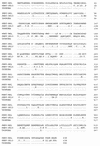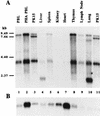Identification of a full-length cDNA for an endogenous retrovirus of miniature swine
- PMID: 9557749
- PMCID: PMC109691
- DOI: 10.1128/JVI.72.5.4503-4507.1998
Identification of a full-length cDNA for an endogenous retrovirus of miniature swine
Abstract
Endogenous retroviruses of swine are a concern in the use of pig-derived tissues for xenotransplantation into humans. The nucleotide sequence of porcine endogenous retrovirus taken from lymphocytes of miniature swine (PERV-MSL) has been characterized. PERV-MSL is a type C retrovirus of 8,132 bp with the greatest nucleic acid sequence identity to gibbon ape leukemia virus and murine leukemia virus. Constitutive production of PERV-MSL RNA has been detected in normal leukocytes and in multiple organs of swine. The copy numbers of full-length PERV sequences per genome (approximately 8 to 15) vary among swine strains. The open reading frames for gag, pol, and env in PERV-MSL have over 99% amino acid sequence identity to those of Tsukuba-1 retrovirus and are highly homologous to those of endogenous retrovirus of cell line PK15 (PK15-ERV). Most of the differences in the predicted amino acid sequences of PK15-ERV and PERV-MSL are in the SU (cell attachment) region of env. The existence of these PERV clones will enable studies of infection by endogenous retroviruses in xenotransplantation.
Figures



References
-
- Armstrong J A, Porterfield J S, De Madrid A. C-type particles in pig kidney cell lines. J Gen Virol. 1971;10:195–198. - PubMed
-
- Auffray C, Rougeon F. Purification of mouse immunoglobulin heavy-chain messenger RNAs from total myeloma tumor RNA. Eur J Biochem. 1980;107:303–314. - PubMed
-
- Ausubel F M, Brent R, Kingston R E, Moore D D, Seidman J G, Smith J A, Struhl K, editors. Current protocols in molecular biology. New York, N.Y: John Wiley & Sons, Inc.; 1995.
Publication types
MeSH terms
Substances
Associated data
- Actions
- Actions
- Actions
LinkOut - more resources
Full Text Sources
Other Literature Sources
Research Materials
Miscellaneous

